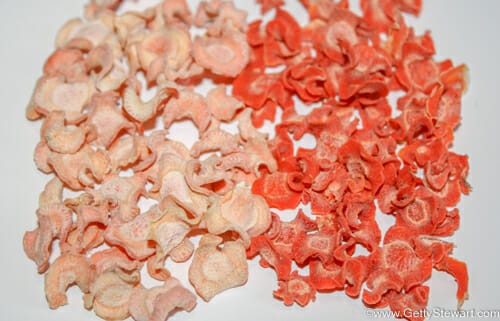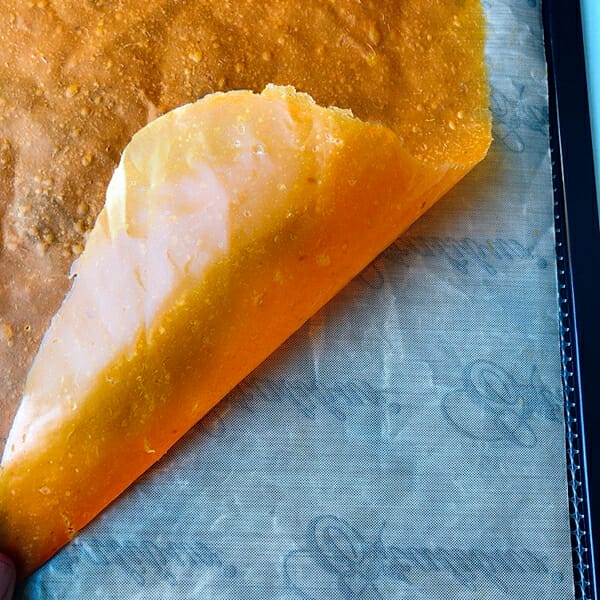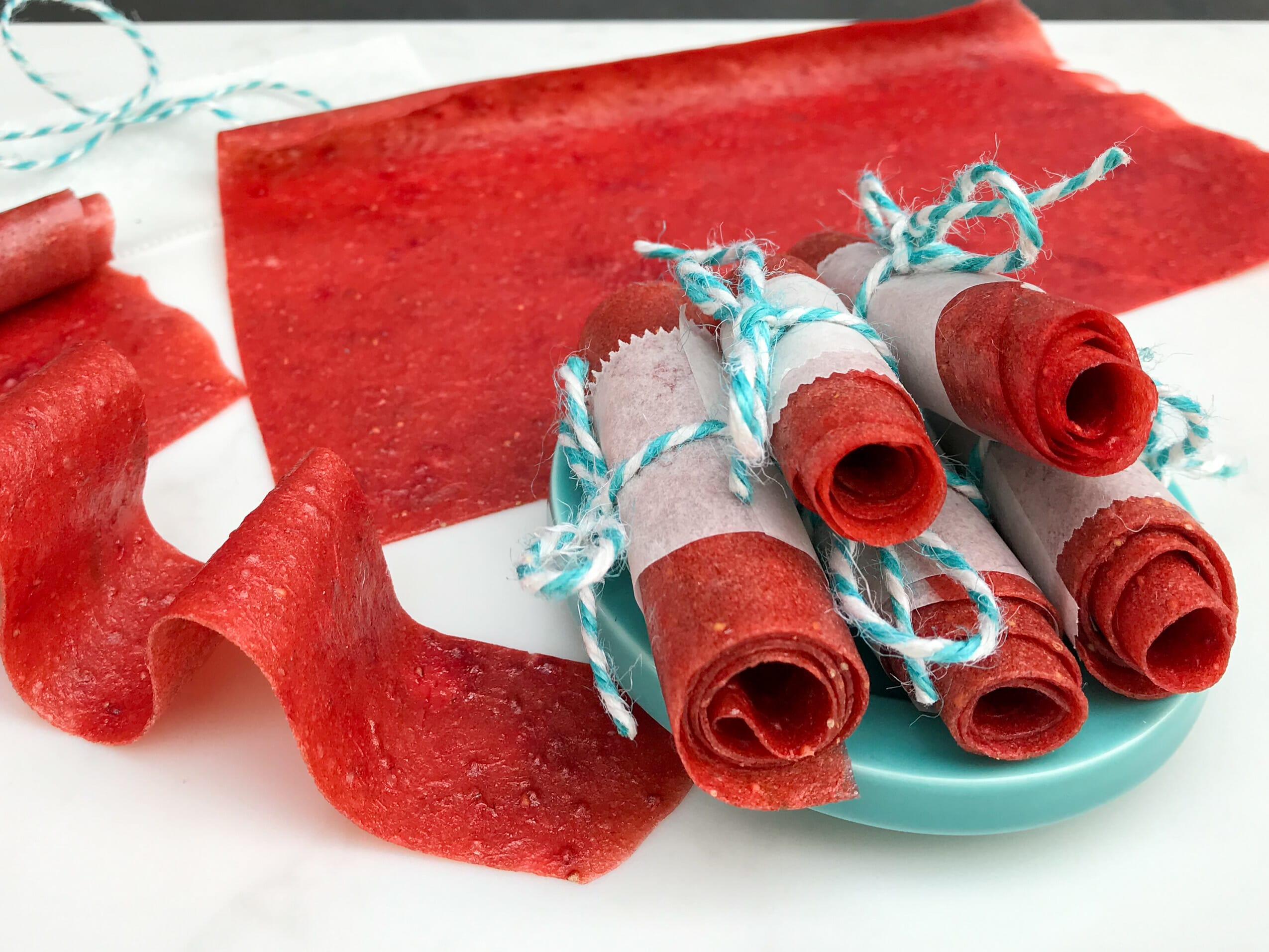Top Twelve Tips for Dehydrating Food
I’m happy to share my top tips for dehydrating food with you which I’ve only shared in my dehydrating workshops before. I hope you find them useful.
Also Read: Tips for Storing Dehydrating Food, My Favourite Dehydrator, Favourite Dehydrating Recipes
Top Twelve Tips for Dehydrating Food
1.Use the Right Temp
Dehydrating is different than roasting or cooking food. It’s drying food and it’s important to keep the heat low! Higher temperatures will harden the outside of the food leaving moisture trapped in the middle. This is called “case hardening” and can lead to mold and spoiled food. Always use the recommended temperature as shown below.
Herbs 95°F/35°C
Mushrooms 100°F/38°C
Vegetables 125°-135°F/52°-57°C
Fruit Leathers or Vegetable Barks 135°F /57°C
Meat, Fish, Jerky 155°F /68°C
2.Control Moisture at All Times
Dehydrating makes food safe for storing at room temperature because bacteria, mold and other pathogens cannot survive without water. Dehydrated food is only safe as long as 80-90% of the water is removed and is not re-absorbed during storage. It’s all about controlling moisture.
3.Prepare Foods Properly
Proper preparation is key to long lasting colour, flavour, nutrient retention and storage. You have to blanch vegetables, cook meat or eggs before drying, dip fruits like apples, pears and apricots in anti-browning solution and check fruits like blueberries and cranberries to allow moisture to escape. Follow instructions and rely on information from trusted, credible sources.

4.Use Quality Produce
Use tasty, high quality food and fresh, ripe, unblemished produce for dehydrating. Remember, what you put in, is what you get out – only in a smaller, drier, more intense form.
5.Don’t Dry Fatty Foods
Fats and foods high in fat (dairy, meat, sauces with oil, nuts and seeds, avocado, etc.) are not suitable for dehydrating. Fat leaves an oily film on food and will cause it to go rancid if stored at room temperature.

6.Enjoy The Difference of Home Dried
Homemade dehydrated or dried food is not the same as freeze dried or commercial dried food. Freeze drying is a different process and commercially dried food often has other additives. For example, homemade banana chips, apple rings and fruit leather will be different than store bought versions – yours will be healthier with less sugar, salt and preservatives.

7.Use Spices and Sweeteners Cautiously
Flavours become concentrated when dehydrated so use added ingredients like sweeteners, salt, spices or extracts sparingly.
8.Dry Multiple Foods at a Time
You can dry multiple foods at the same time on different trays in your dehydrator. Just be sure they have similar taste profiles to avoid unpleasant cross over of flavours. For example, dry peas and carrots at the same time but avoid drying apples and leeks together.

9.Don’t Use Wax Paper
For foods high in liquid, line mesh trays with liners that come with the dehydrator, parchment paper or plastic wrap. Never use wax paper. It will not separate from dried food.

10.Over-Drying is Better than Under-Drying
Err on the side of over-drying rather than under-drying. Remember even a little bit of moisture will allow bacteria and mold to survive. That said, if your fruit leather or food is too dry and brittle you can strategically re-introduce moisture by adding a damp cloth or sponge to the container of dried food. The food will re-absorb some of that moisture, but avoid direct contact between the food and the cloth, use some sort of barrier. For a look at how I recover from fruit leather that’s too dry, watch this brief video
https://youtu.be/gwMJx7TvvWU
11.Store Food Effectively
Storing dried food well is key. Use tightly sealed containers kept in a dry, dark, cool place. The cooler the better. Check out my tips for storing dried food. Vacuum sealing and oxygen absorbers are helpful if you’re planning to store food for more than a year. Otherwise, as long as you follow the general tips for storing dried food, they are optional.
12.Start With Easy Foods
Some foods are easier to dehydrate than others. Fruits, vegetables, herbs, beans and grains are easier to dehydrate than meats, dairy, eggs and whole meals that require more knowledge and careful preparation for good, safe results.
Dried Pineapple – Fresh, Frozen or Canned
Dehydrated Apple Almond Snack Bars
How to Make Scalloped Potatoes with Dried Potatoes
How to Dry Rice for Instant Rice
I hope you find these top tips for dehydrating food helpful.
Do you have any questions about storing dried food? What tips or ideas can you add to the list? I love getting reader’s questions and the opportunity to learn more. Leave a comment below or tag me on Instagram @getgettys and Facebook @GettyStewart.HomeEconomist.
Getty Stewart is a Professional Home Economist, speaker, frequent media guest and writer dedicated to putting good food on tables and agendas. She is the author of several recipe books on enjoying and preserving fruit, Founder of Fruit Share, a mom and veggie gardener. Sign up to get articles by Getty delivered to your inbox. You’ll get recipes, practical tips and great food information like this.
Get all my best Dehydrated Recipes & Tips




I love dehydrating nature’s bounty! A number of years ago I tried drying my plentiful berries and thought they ended up tasting like space food. Remember pop rocks? Anyway I still didn’t want to toss them so I tried grinding them into a fine powder. Today I love fruit powders and use them to flavor whipped cream (raspberry!), frosting, baked good, or sweeten tea. Then two years ago I got into making (50%) herb salt blends. I did one with blackberries and it is so beautiful…a dark purple salt looks great on light colored foods and salmon. It does not taste real fruity but the whole berry is in there!
Love the sounds of your blackberry salt. Yes, highly seedy berries – raspberries and blackberries are very crunchy! When I make fruit leather with them, I strain or blend them first. The fruit powders are great in shelf stable camping food too like homemade instant oatmeal. Sounds like you’re enjoying all things dehydrating – that’s great.